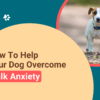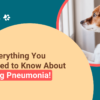
Living Comfortably with Canines: Comprehensive & Effective Guide on 7 Proven Ways to Manage and Alleviate Dog Allergies
Did you know that countless people around the world sneeze, sniffle, and itch due to dog allergies? And no, we’re not exaggerating! Whether it’s you, a friend, or a family member, these allergies can genuinely make life a tad more challenging. But here’s the deal – having dog allergies doesn’t mean you need to give up your dream of cuddling with a furry friend.
Welcome to our guide where we’re all about helping you manage these pesky allergies. This isn’t about quick fixes, but rather effective and reliable strategies that can bring you real relief. We understand the struggle is real and we’re here to help you keep the sneezes at bay. So, get comfortable, because you’re about to learn how to live happily and healthily with your beloved canine companions, even if your body seems to want to play tricks on you. Let’s roll up our sleeves and dive into it, shall we?
Understanding Dog Allergies
Picture this, you’re hanging out with your pooch, but within minutes your eyes start watering and you’re sneezing like there’s no tomorrow. That’s your body’s immune system reacting to harmless proteins found in a dog’s skin cells, saliva, or urine. They perceive these proteins as foreign invaders, much like a flu virus, leading to an allergic reaction. And let’s not forget, these symptoms aren’t just annoying; they can disrupt your daily life.
Speaking of symptoms, let’s talk about what you might experience. The most common ones are red, itchy eyes, sneezing, and a runny nose. But wait, there’s more. Some unlucky folks may also experience hives on their face or chest or even asthma symptoms like difficulty breathing and chest tightness. It’s a game of roulette, really.
What’s more interesting, according to a 2020 study, women are more likely to develop dog allergies than men. Plus, you’re more at risk if you have other allergies or asthma. Not the fun facts we want, but they’re good to know, right? Knowledge is power when it comes to handling these allergies.
7 Proven Ways To Manage And Alleviate Dog Allergies
Regular Cleaning and Grooming of the Dog
Let’s get started on tackling these allergies head-on! First stop: regular cleaning and grooming of your canine companion. Now, you might be thinking, “Of course, clean dogs are happy dogs.” But, it goes way beyond that in the context of allergies.
Grooming isn’t just about making your dog look good for those Instagram pictures, it’s a crucial step in managing dog allergies. It’s all about reducing exposure to the allergens. When you regularly bathe and brush your dog, you’re effectively removing those allergens that are stuck on their fur, skin, and in their saliva. Plus, a cleaner dog means a cleaner home environment.
And the results are backed by science, too. A study by the American Journal of Rhinology & Allergy showed that washing pets at least twice a week reduced the levels of allergens in the environment significantly. So, you see, keeping up with Fido’s hygiene isn’t just good pet ownership, it’s your ticket to breathing easier and living better with your furry pal. You get an adorably clean pup and fewer allergy symptoms to deal with. Now, that’s what we call a good deal!
Air Purification
Let’s now shift our focus to the second strategy: air purification. You might think of air purifiers as gadgets that simply freshen up your indoor air, but they do so much more, especially for those with allergies.
There are a couple of key types of air purifiers we recommend for combating dog allergens. The first is a True HEPA filter, which can capture 99.97% of particles as small as 0.3 microns – that includes those pesky dog allergens. Another great option is an Ultra Low Penetration Air (ULPA) purifier. This powerhouse can trap 99.99% of particles down to 0.12 microns. If you’re serious about nipping those allergies in the bud, these are the weapons you want in your arsenal.
By capturing these allergens, air purifiers can significantly reduce the concentration of allergens in your home, helping to relieve symptoms. And don’t just take our word for it. A 2018 study published in the Journal of Allergy and Clinical Immunology confirmed that the use of air purifiers resulted in a noticeable reduction in allergic symptoms among pet owners. So, investing in a quality air purifier isn’t just a luxury, it’s a necessity for those looking to keep dog allergies under control.
Opt for Hypoallergenic Dog Breeds
Alright, let’s take a different approach and delve into another alternative: hypoallergenic dog breeds. You’ve probably heard this term thrown around, but what exactly does it mean? Well, in simple terms, hypoallergenic dogs are breeds that are less likely to trigger an allergic reaction. They produce fewer allergens, making them a more suitable choice for allergy sufferers.
Let’s clarify though, no dog is 100% hypoallergenic. However, certain breeds produce fewer allergens and shed less, and this combination can make a world of difference for people with allergies.
A few examples of such breeds include the Poodles and Poodle mixes like the Labradoodle and Goldendoodle. Their curly hair is less likely to shed, which means fewer allergens floating around your home. Another breed is the Bichon Frise, a small breed with a thick double coat that hardly sheds. Shih Tzus, Portuguese Water Dogs, and Schnauzers are other popular hypoallergenic breeds.
So, if you’re thinking of adding a dog to your family and allergies are a concern, these breeds could be a good fit. They prove that you can live with a dog and manage allergies effectively at the same time. It’s all about finding the right match for your situation.
Proper Personal Hygiene
On to the next one: personal hygiene. This might seem like a no-brainer, but when it comes to managing dog allergies, it’s more important than you might think. Every cuddle session with your furry pal leaves allergens on your hands, clothes, and even your face.
Here’s the thing, it’s not just about washing your hands after petting your dog, although that’s crucial. It’s about being conscious of your interaction with your pet and taking care of your personal hygiene accordingly.
So, what should you be doing? Firstly, always wash your hands after playing with your dog. Don’t touch your face or eyes until you’ve done this – it’s an easy way for allergens to enter your body and trigger a reaction.
Clothing is another hotspot for allergens. Changing your clothes after prolonged contact with your dog and washing them regularly can help reduce allergen buildup.
And, if your allergies are severe, consider showering before bed. This helps to wash off any allergens that may have ended up on your skin or in your hair, preventing them from making their way onto your bedding.
Lastly, don’t forget regular dental hygiene. Brushing and flossing can help remove allergens from your mouth. This might seem like overkill, but studies, including one from the University of Maryland, have shown that good oral hygiene can actually reduce allergic reactions.
Use of Anti-Allergen Sprays and Products
Let’s jump into our next strategy: using anti-allergen sprays and products. There’s a whole market out there dedicated to combating allergens in your home and for good reason.
These products work by neutralizing or encapsulating the allergens, rendering them less likely to trigger an allergic reaction. They can be a game-changer when it comes to managing allergies. But let’s get one thing straight: they’re not a standalone solution, but rather a piece of the allergy-management puzzle.
There’s quite a range to choose from, including sprays, laundry additives, and even shampoos for your dog. The key is to look for products specifically designed to combat pet allergens.
Now, the trick to using these products effectively is consistency. Spray them on your upholstery, carpets, and even curtains regularly. If you’re using an anti-allergen laundry additive, make sure to wash your clothes and bedding with it often. And if you opt for an allergen-reducing shampoo for your dog, establish a regular bathing schedule.
Allergy Shots (Immunotherapy)
Alright, now we’re moving onto some of the big guns in the fight against dog allergies: allergy shots or, as the pros call it, immunotherapy.
Here’s how it works: immunotherapy involves introducing small, controlled amounts of the allergen (in this case, dog dander) into your body, usually via injection. Over time, the aim is to make your immune system less reactive to allergens, reducing the severity of your allergic reactions.
Now, this might sound like an attractive option, but it’s important to consider the pros and cons. On the plus side, immunotherapy has been proven to be effective. A review of studies published in the Lancet found that it can significantly reduce symptoms and medication needs for people with allergic rhinitis – the fancy name for hay fever, which shares many symptoms with dog allergies.
On the downside, immunotherapy is a long-term commitment, often taking months to years to see significant improvement. It also requires regular visits to a healthcare professional for the injections. Plus, while rare, there’s a risk of severe allergic reactions to the shots themselves.
So, while immunotherapy can be an excellent option for some, it’s essential to have a detailed discussion with your healthcare provider to see if it’s the right path for you.
Medications
Last but not least, let’s chat about the role of medications in managing dog allergies. This can be a lifeline for many, providing immediate and effective relief from symptoms.
Over-the-counter antihistamines like Cetirizine (Zyrtec), Fexofenadine (Allegra), and Loratadine (Claritin) are often the first line of defense. They work by blocking histamine, a chemical your body releases during an allergic reaction, reducing symptoms like itching and sneezing.
Another class of medication is nasal corticosteroids, such as Fluticasone (Flonase) and Mometasone (Nasonex). These help to reduce inflammation and can be particularly effective for nasal symptoms.
However, while these medications can help control symptoms, they’re not without potential side effects. For some, antihistamines can cause drowsiness, dizziness, and dry mouth, while nasal corticosteroids might lead to nosebleeds or sore throat.
Additionally, it’s worth noting that medications aren’t a cure for allergies – they’re more of a Band-Aid, helping to manage symptoms rather than getting rid of the allergies altogether.
As always, it’s essential to have a chat with your healthcare provider to find out which medications might be best for you, taking into consideration your symptoms, general health, and lifestyle. Remember, managing allergies is about finding what works for you – it’s not a one-size-fits-all solution.
Precautions And Tips When Dealing With Dog Allergies
Wrapping things up, let’s talk about some key considerations and tips for navigating life with dog allergies.
Firstly, before adopting or buying a dog, take the time to consider your decision carefully. Think about your lifestyle and your willingness to undertake the measures needed to manage allergies. Remember, certain breeds may be better suited to those with allergies, but no breed is entirely allergen-free.
And here’s a tip: try spending time with the dog breed you’re considering. This can give you an idea of how your body might react, reducing the chance of any unpleasant surprises later.
Secondly, and this cannot be stressed enough: consult with a healthcare provider. Whether you already own a dog and are struggling with allergies, or you’re considering getting one, professional advice is invaluable. They can help guide you on the best methods to manage your allergies, including the possibility of medication or immunotherapy.
Navigating dog allergies might seem daunting, but with a thoughtful approach, it’s entirely possible to live comfortably with your furry friends.
Final Thoughts
As we wrap up this deep dive into managing dog allergies, remember this: You’re not alone, and more importantly, you’re not without options. We’ve explored various strategies – from regular cleaning and grooming, air purification, considering hypoallergenic breeds, maintaining good personal hygiene, using anti-allergen products, immunotherapy, and medications. Each offers a unique approach and benefits, but the key is finding the right combination that works for you.
Life with dog allergies doesn’t mean you have to forego the joy of having a canine companion. It simply means adjusting your game plan. Keep the conversation going with your healthcare provider, stay informed, and stay proactive. With a bit of strategy and planning, you can live a comfortable and fulfilling life with your four-legged friend. Let your love for dogs guide you – it’s absolutely worth the effort.






